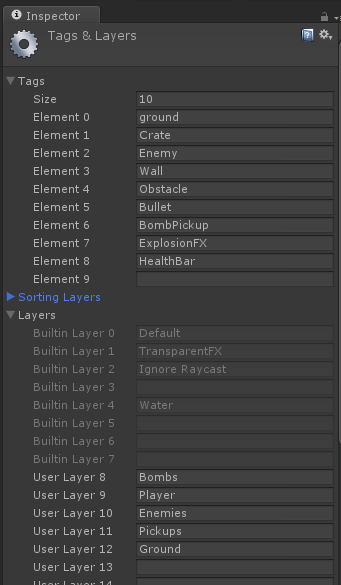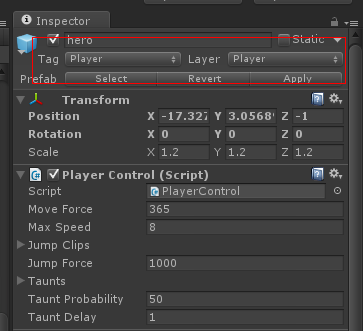游戏对象的Tag和Layer


tag可以理解为一类元素的标记,如hero、enemy、apple-tree等。通过设置tag,可以方便地通过GameObject.FindWithTag()来寻找对象。GameObject.FindWithTag()只返回一个对象,要想获取多个tag为某值的对象,GameObject.FindGameObjectsWithTag()。
每个GameObject的Inspector面板最上方都也有个Layer选项,就在Tag旁边,unity已经有了几个层,我们新建个层,也叫UI,点击Add Layer,可以看到从Layer0到Layer7都灰掉了,那是不能用的,从第八个起可以用,Layer和tag还有一个很大的区别就是layer最多只能有32个层。
在使用过程中,使用Culling Mask、Layer Mask的地方实际指的就是layer。下面我们来看一段使用layer来检测碰撞的代码:
Ray ray1 = nguiCamera.camera.ScreenPointToRay(Input.mousePosition);
RaycastHit hit1;
LayerMask mask = 1 << LayerMask.NameToLayer("UI");
if (Physics.Raycast(ray1, out hit1, 600, mask.value))
{
return;
}
LayerMask的NameToLayer是通过层的名称返回该层的索引,如果是8,然后1<<8换算成LayerMask值,再用LayerMask的value就可以了。注意也必须设置collider才能接收碰撞,这里才能判断到。LayerMask实际上是一个位码操作,在Unity中Layers一共有32层,这个是不能增加或者减少的: 1 << LayerMask.NameToLayer("UI") 这一句实际上表示射线查询只在UI所在这个层级查找是返回的该名字所定义的层的层索引,注意是从0开始。
下面我们来看一个玩家控制的脚本,利用 Physics2D.Linecast检测物体是否碰撞到地面。
using UnityEngine;
using System.Collections;
public class PlayerControl : MonoBehaviour
{
[HideInInspector]
public bool facingRight = true; // For determining which way the player is currently facing.
[HideInInspector]
public bool jump = false; // Condition for whether the player should jump.
public float moveForce = 365f; // Amount of force added to move the player left and right.
public float maxSpeed = 5f; // The fastest the player can travel in the x axis.
public AudioClip[] jumpClips; // Array of clips for when the player jumps.
public float jumpForce = 1000f; // Amount of force added when the player jumps.
public AudioClip[] taunts; // Array of clips for when the player taunts.
public float tauntProbability = 50f; // Chance of a taunt happening.
public float tauntDelay = 1f; // Delay for when the taunt should happen.
private int tauntIndex; // The index of the taunts array indicating the most recent taunt.
private Transform groundCheck; // A position marking where to check if the player is grounded.
private bool grounded = false; // Whether or not the player is grounded.
private Animator anim; // Reference to the player's animator component.
void Awake()
{
// Setting up references.
// 在子对象里面找到groundCheck
groundCheck = transform.Find("groundCheck");
// 获取当前的动画控制器
anim = GetComponent<Animator>();
}
void Update()
{
// 是为能随时检测到groundCheck这个物体,添加一个名叫Ground的Layer,然后把场景中的所有代表地面的物体的Layer设为Ground
// 这里用到了2D射线检测Physics2D.Linecast()
// LayerMask实际上是一个位码操作,在Unity3d中Layers一共有32层,这个是不能增加或者减少的:
// 1 << LayerMask.NameToLayer("Ground") 这一句实际上表示射线查询只在Ground所在这个层级查找 是返回的该名字所定义的层的层索引,注意是从0开始
// 每个GameObject的Inspector面板最上方都也有个Layer选项,就在Tag旁边,unity3d已经有了几个层,我们新建个层,也叫UI,点击Add Layer,可以看到从Layer0到Layer7都灰掉了,那是不能用的,从第八个起可以用,所以在第八个建个UI的层。
// 一般情况下我们只用前两个参数,distance表示射线距离,默认是无限远,重点是最后一个参数layerMask,专门处理layer过滤的,是个整型,怎么用呢,是靠layer的二进制位来操作的
// LayerMask的NameToLayer是通过层的名称返回该层的索引,这里是8,然后1<<8换算成LayerMask值,再用LayerMask的value就可以了。
// 注意也必须设置collider才能接收碰撞,这里才能判断到。
grounded = Physics2D.Linecast(transform.position, groundCheck.position, 1 << LayerMask.NameToLayer("Ground"));
// If the jump button is pressed and the player is grounded then the player should jump.
// 如果点击了跳的按键,并且已经着陆,那么就可以跳起来
if(Input.GetButtonDown("Jump") && grounded)
jump = true;
}
// 因为主角游戏对象要使用到刚体力,所以一定要写在FixedUpdate里面,不能放在Update上
void FixedUpdate ()
{
// Cache the horizontal input.
// 换取水平方向的移动距离
float h = Input.GetAxis("Horizontal");
// The Speed animator parameter is set to the absolute value of the horizontal input.
// 设置动画的速度变量
anim.SetFloat("Speed", Mathf.Abs(h));
// 给物体添加一个水平的力,让它移动的时候会产生惯性的效果
// If the player is changing direction (h has a different sign to velocity.x) or hasn't reached maxSpeed yet...
// 如果速度小于最大的速度
if(h * rigidbody2D.velocity.x < maxSpeed)
// ... add a force to the player.
rigidbody2D.AddForce(Vector2.right * h * moveForce);
// If the player's horizontal velocity is greater than the maxSpeed...
if(Mathf.Abs(rigidbody2D.velocity.x) > maxSpeed)
// ... set the player's velocity to the maxSpeed in the x axis.
rigidbody2D.velocity = new Vector2(Mathf.Sign(rigidbody2D.velocity.x) * maxSpeed, rigidbody2D.velocity.y);
// 转身
// If the input is moving the player right and the player is facing left...
if(h > 0 && !facingRight)
// ... flip the player.
Flip();
// Otherwise if the input is moving the player left and the player is facing right...
else if(h < 0 && facingRight)
// ... flip the player.
Flip();
// If the player should jump...
if(jump)
{
// Set the Jump animator trigger parameter.
// 触发跳的动画
anim.SetTrigger("Jump");
// Play a random jump audio clip.
int i = Random.Range(0, jumpClips.Length);
AudioSource.PlayClipAtPoint(jumpClips[i], transform.position);
// Add a vertical force to the player.
// 添加一个垂直的力
rigidbody2D.AddForce(new Vector2(0f, jumpForce));
// Make sure the player can't jump again until the jump conditions from Update are satisfied.
jump = false;
}
}
// 转身
void Flip ()
{
// Switch the way the player is labelled as facing.
facingRight = !facingRight;
// Multiply the player's x local scale by -1.
Vector3 theScale = transform.localScale;
theScale.x *= -1;
transform.localScale = theScale;
}
public IEnumerator Taunt()
{
// Check the random chance of taunting.
float tauntChance = Random.Range(0f, 100f);
if(tauntChance > tauntProbability)
{
// Wait for tauntDelay number of seconds.
yield return new WaitForSeconds(tauntDelay);
// If there is no clip currently playing.
if(!audio.isPlaying)
{
// Choose a random, but different taunt.
tauntIndex = TauntRandom();
// Play the new taunt.
audio.clip = taunts[tauntIndex];
audio.Play();
}
}
}
int TauntRandom()
{
// Choose a random index of the taunts array.
int i = Random.Range(0, taunts.Length);
// If it's the same as the previous taunt...
if(i == tauntIndex)
// ... try another random taunt.
return TauntRandom();
else
// Otherwise return this index.
return i;
}
}